My summers in Cragsmoor, New York, 1920-1935
In later years, Gretchen (my wife) and I reflected that a major reason we all got away to Cragsmoor each summer was the fear of polio. But get away we did.
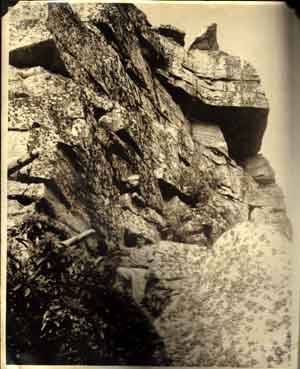
From an early age I can remember the enormous task of packing the car with the whole family, two parents, five children, one maid, and sometimes a cat, with all our baggage into the old Studebaker. Dad took long vacations in the summer. The Munson Institute was shut down and he got someone to take his church services on Sundays.
Trunks had been sent on ahead, but it still was a major operation which took most of the morning. The worst part was actually the trip itself. Almost always we had tire trouble. Also some mechanical emergency would usually force long delays, not to mention stops to eat and go to the bathroom. The distance from Brooklyn was about 110 miles, North and slightly West. Years later we used to make the trip in 3 hours, but then it was an all-day experience.
The excitement would grow as we climbed the mountain winding through the woods until finally we could see Bear Cliff, the rock formation that crowned our mountain. (Years later on visiting Cragsmoor after having seen the Dolomite mountains in Italy, I realized it was a rather small mountain -- perhaps 1200 feet above sea level). It was always a game to see who could see it first. But then we had to pass Miss Wright’s farm and enter onto our private drive that continued for about one half of a mile to the crossroads where the coming and going roads of the Lee Void Lodge converged on us. It was an unkempt dirt road with deep drainage ditches on each side, grass growing in the middle, and flanked on the sides by overgrown fields. Another two turns and we could see our beloved cottage. (All the houses in the Cragsmoor area were called "cottages." I suppose because with very few exceptions they had no central heat and no insulation).
Living Arrangements
By present day standards it wasn’t much of a second 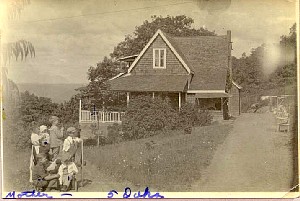 home. Small living room, small dining room, large wrap-around covered porch, kitchen and bathroom on the first floor. One large and two medium sized bedrooms on the second floor. Weathered shingles on exterior walls and sloping roofs. Stained vertical tongue and groove wainscotting for the interior walls. Furnished inexpensively. An upright piano in the living room which opened without doors into the dining room. Wicker furniture for easy chairs. A simple, rectangular, maple-stained wooden dining room table with eight straight-backed chairs filled most of the space available in the dining room.
home. Small living room, small dining room, large wrap-around covered porch, kitchen and bathroom on the first floor. One large and two medium sized bedrooms on the second floor. Weathered shingles on exterior walls and sloping roofs. Stained vertical tongue and groove wainscotting for the interior walls. Furnished inexpensively. An upright piano in the living room which opened without doors into the dining room. Wicker furniture for easy chairs. A simple, rectangular, maple-stained wooden dining room table with eight straight-backed chairs filled most of the space available in the dining room.
On good days we used to eat out on the porch, which gave rise to one of our family sayings: "Don’t go out empty handed," Dad would say. If every one helped clear, it was easier to get the dirty dishes through the dining room and into the kitchen at the end of the meal.
We had an ancient grape vine that provided a screen in the way of our view to the South (away from Bear Cliff) from our much lived-in porch. Dad used to delight in "feeding the grape vine," by pouring leftover liquids over the railing. He had a similar practical approach to building up the bank of the road that circled from the kitchen door, down and around our great five-trunked oak tree and back beside the grape vine on its way back up to join the incoming road. He encouraged us to dump trash there! You couldn’t see it easily for the bank was fairly deep and largely hidden by wild sumac. Funnily enough, it wasn’t much of an eye sore and it really seemed to work.
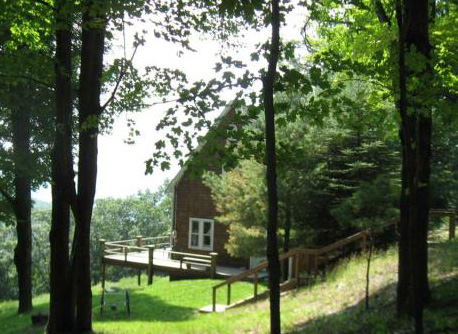
Our cottage sat on one acre on the sloping side of the mountain surrounded by some 78 acres that Mother’s father (whom we called Dada) had bought. Lest you think this was some beautiful estate, let me state that almost all of these acres were rocky, wooded and on a sloping mountain side. At one point the land must have been farmed, at least in part, because there were wild vestiges of what must have been cultivated fields in the dim past. It was a constant battle to prevent these fields from relapsing into underbrush and ultimately forest.
There was one other cottage on Dada’s property, the "Upper House," which was higher up and at the start of the trail we took through the woods to get to Bear Cliff. He had given it to his other daughter, Aunt Helen. But she never used it. Instead, Dada and various elements of his family would take turns using it. Many summers it stood idle.
Except for the Lee Vold Lodge, a large 3-story boarding house that had been successively extended from the original small farmhouse atop a bill to our East, we never had any close neighbors. The Lee Vold was run by a Mrs Larson and her sister Miss Lee (Helen I think), relatives of Dada’s whose family had been good to him in Norway as a small boy. He either gave them the property or made it very easy for them to buy it.
The Lee Vold Lodge was ultimately torn down after my brother Henry bought the property. The wrecking company paid him $1500 to demolish with the lumber, furniture and furnishings going to them to sell. That was fine with Henry, who had long referred to the structure as a "hideosity" and was happy to get rid of it. Many years later, when I went antique hunting with Gretchen, I was to see the same kind of porcelain basins and pitchers that the Lee Void had in every sleeping room. The Lodge guests all had to use public bathrooms. Some of the ugly furniture in the living room and parlor seemed to re-appear likewise in antique shops.
Even in my memory span, for several years we had neither electricity nor telephone service. We used candles and kerosene lamps for lighting and a kerosene stove for cooking. My job was to fill the lamps and the glass container on the stove with kerosene. We had an old wood stove in the kitchen that had once been the only means for cooking and was still needed for many years to get hot water. We had no furnace. A few kerosene heaters were available on cold days, which I also had to keep filled. We got deliveries of ice for our ice box which we kept under the porch, but we had to take care of our own trash and garbage.
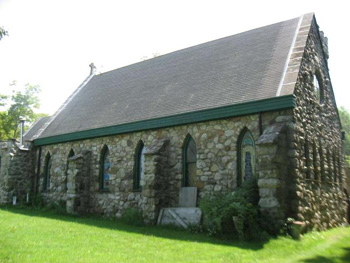
A Miss Wright, whose farm was located next to the entrance to our driveway, used to come on two days a week to get our order for food and supplies. She seemed very old to me and had a pinched mouth as though she hadn’t really taken care of her teeth. She did this for many Cragsmoor residents. She would drive her Model T Ford station wagon on the "Gully Road" down the mountain to Ellenville, where she did all her shopping and then made deliveries later in the day or the next morning. She would get anything for us. I remember ordering such things as a kite and a scout knife. She let us run a tab for the whole summer and got paid in the Fall. How she kept her vendors at bay escapes me. She was devoted to Mother, which I think partly explains the excellent service she continued to give the family for many years.
Cragsmoor was mostly a summer community. There were three outstanding features. The Cragsmoor Inn, surrounded by a nine-hole golf course was a ten minute walk through the woods and a 15 minute drive back to the main highway and around to the North.. Beyond the Inn and next to the seventh hole on the golf course was what passed itself off as the central village. It consisted of the post office with a gasoline pump and soda fountain on one side along with the Catholic Church. On the other side was the Protestant church, from which you could hear familiar hymns as you hit your golf ball to the seventh green on a Sunday. Next to the church was the Cragsmoor Free Library. The third notable feature was the Episcopal Church about a mile farther along. Made of fieldstone, it was perched atop a ridge that fell sharply away to a stream far below. As a result, it provided a breath-taking view of the Catskill mountains farther to the North. The church was probably visited more by sightseers than church-goers.
View from the Episcopal Church
Activities
Well, that’s the setting. Now, what did we do with it?
Much of our activity was family centered. Since there were quite a few of us, and often had guests (who must have stayed at the Lee Void Lodge). We would entertain each other. We loved to go on picnics. Sometimes we went to places in the valley which had swimming facilities. Other times we packed our picnic on our backs and went down to a number of groves we had prepared for this purpose in the woods below our house. We had a pine grove and a birch grove, for two that I remember. We would often do this in the evening and have campfires, which gave appropriate settings for ghost stories and singing.
Conversation, a much-neglected art today, was an important part of our lives. I can remember as a small boy listening to adult conversation as we all sat around the living room after dinner. Usually on such occasions we would have had a guest or two for dinner who added special interest to the sharing of views. Sometimes it would be a member of the staff at Dad’s school, or a minister that Mother had gotten to know in one of her varied religious activities. Once we had the tympanist from the Boston Symphony orchestra, a Mr. White, who held us all spell bound by his narratives.
A Cragsmoor resident, Lloyd Almiral, would occasionally join us. He was a member of a more wealthy Cragsmoor family and made almost annual visits to Beyreuth to hear Wagner operas, which impressed me immensely. Dad would often play the piano for us. We had no TV to watch, no radio to which to listen, nor any home movies to show. But I would sit there quietly, listening to their talk, hoping no one would notice it was past my bedtime, until I could keep my eyes open no longer.
Frequently, as I worked thy weary way to bed I would beg Dad to "Play Beethoven" for me. I wasn’t trying to impress anybody. But at an early age I had developed a great liking for this composer. He created a good deal of piano music, which when I hear it today strongly reminds me of lying in my comfortable bed in Cragsmoor, listening to my father play Beethoven sonatas and other pieces. Just to add a further touch of drama, I often associate this with the sound of rain on the roof. We had very little roof between us and the rain, which produced a dramatic pounding when the rain came down hard.
People
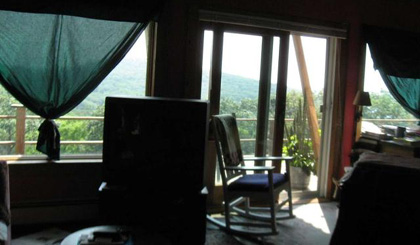
If Mother dominated my early years in Brooklyn, my brother Henry - certainly after Mother’s death in an automobile accident in 1929 - has to be said to dominate my Cragsmoor years. Since he remained unmarried until after World War II, and lived in New York City -- an easy week-end trip away -- it isn’t surprising that he developed the strongest attachment to Cragsmoor. He would look across the fields at the distant valley and be clearly thrilled by the magnificent view. In later years he would organize groups of friends to go to Cragsmoor for weekends. The rule was to work in the mornings, enjoy a mid-day martini (or two!) and relax in the afternoons. (A policy I adopted when I brought Harvard friends to work around the place during Easter vacations). His favorite comment, when we would rest from our heavy labors clearing some fields, was "It’s truly Wagnerian," his way of extending highest praise to an unspoiled mountain scene. His eyes would mist a little and his face would reflect such intense pleasure.
Henry ultimately succeeded to the ownership of the whole place Dada had once bought. It didn’t occur without some hard feelings, although we all had to agree he was in the best position to take care of it. It was Henry who would organize shingling projects to keep the roof sound; extend the small, second floor porch, and, much later, build a fireplace in the living room to make the house more comfortable in off-seasons. He would even get me to go with him on "transplanting" expeditions, which usually took place in bad weather and which I didn’t particularly enjoy.
Dad also loved Cragsmoor in his quiet way. I don’t think he ever got over losing Mother. He broke down completely when he saw her lying in the casket in our living room in Garden City when the finality of the situation fully struck him. (I’m sure this is the reason I am bitterly opposed to the practice of viewing the body). Most probably the place evoked continuing memories of her, which warmed him and saddened him at the same time. He loved to sit in a rocking chair on the porch reading a good book, feeling the breeze play with his thinning hair. He enjoyed our large lilac bush which was a blaze of color in the early Spring. He would also play croquet, a game at which he was very good.
I don’t remember much about Alex in Cragsmoor. He got married, had children and left the family hearth at an early date. He was the architect and principal builder of a large 4-car garage on the property. I helped by carrying nails. It was quite a piece of engineering. The design had two cars side by side, two deep. Then on the second floor, which was never completely finished, there were overflow sleeping quarters. He ran a strong cable from the peak of the roof to the center of the floor (and ceiling) area and supported the floor largely by suspension from the roof
Alex and Henry had to learn plumbing in addition to carpentry, all of which they taught to me. In those days you had a pipe cutter, to cut pipe to the size you wanted and a pipe threader, to put thread on the ends so you could screw the pipe into connectors and sockets. Both, of course, had to be worked by hand. The three of us had to replace the pipe from the hut, halfway up the hill, that contained our water storage tank to the system of pipes for the kitchen and bathroom. The tank, by the way, was filled by pipes that connected it to the gasoline pump and the well near the Lee Vold Lodge, which provided fresh water to all three units.
Marian & Wiggles, particularly Wiggles, benefited from our proximity to the Cragsmoor Inn. Every summer the Inn imported about 7-10 strong young men as waiters, bus boys, dishwashers, etc, who somehow learned -- probably from last year reports -- that there were two lovely girls who lived in a house only a 10 minute walk through the woods. These fellows would come over, help us roll the tennis court, mend fences and do other odd jobs in return for their company. There were dances every Saturday night at the Cragsmoor Inn, which would usually find one or both of my sisters in attendance.. By this time we had electricity and telephones, which made communication easier. Wiggles developed a good tennis game (wooden racquets), which became another drawing card taking us to the Cragsmoor Inn and the Inn help to us,
In those days, girls were expected to take care of kitchen work and housework. But on rainy days, the boys would take over the kitchen and make some special dishes. Sometimes it was candy, other times it was French pancakes or biscuits. We always made a dreadful mess. I guess cooking an entire meal was beneath our dignity! How times change.
As for me, I was much younger than the others. I was allowed to play with them but contributed little. In the early years, Mother used to import playmates for me. One of these was my cousin John who was great company. We slept in the top of the garage Alex built, which is where he taught me about smoking. We loved climbing around Bear Cliff together. I still have a picture he took of me perched on a rock on the face of the cliff. It was while we were doing this that I had my only accident in all the years I spent there. I was picking and eating some blueberries, holding on to a bush with my left hand, when the bush came off at the roots and I went plunging about 10 feet onto some rocks. John was panic stricken; told me to lie still until he could work his way down and came to my aid, Carefully moving one limb at a time I was relieved to find that there was no serious injury. I had scuffed a knee a bit; but that often happened. John was overwhelmed with thanks for my good fortune. He would have been in deep trouble, being two years older than I, if I had really been hurt.
At a relatively early age I started to earn money by caddying. $4.50 for 9 holes and $ 7.50 for 18, per bag. I played more tennis than golf in those days, but gradually switched around to golf. Dad had given a recital for the benefit of the Cragsmoor Country Club for which he got a greens fee ticket that allowed me many free games.Why? I don’t know. Golf was more difficult and more exasperating. But you did get the thrill of hitting a very good shot. More so than in tennis where everything happens so fast.
Somewhere along the line, I think after my brothers and sisters had left the nest, I got a 22 caliber rifle, which I had to keep in Cragsmoor and discipline myself to use most carefully. I remember going to bed with the rifle on the floor under the bed -- not loaded. I fancied myself as a kind of pioneer when I stalked through the woods with it in search of crows. I don’t remember bagging any. But I did shoot at some. I was a great hero when I pointed my gun out of a second story window at the request of the family and successfully shot a frog that had invaded our small goldfish pond underneath the giant oak tree and had annoyed us with its croaking.
You can be sure that having a summer house gave me considerable standing among my friends in Brooklyn. That, and having a backyard to play in. I don’t know why I never had any of these young friends join me in Cragsmoor. It simply never occurred to me. Perhaps because I was the lowest one on the totem pole in terms of influence on family decision making!
Well Kitty (my daughter), I hope this gives you what you wanted. I enjoyed doing it but doubt that your son Paul will find it anywhere near as enjoyable as I did creating it. I wish I could close with some down-to-earth philosophical thought. But I can’t think of any.
All my love,
December 7, 2001
Previous page: My early years in Brooklyn, New York, 1920-1928 Next page: Kitty's remembrances of her parents at their memorial service
